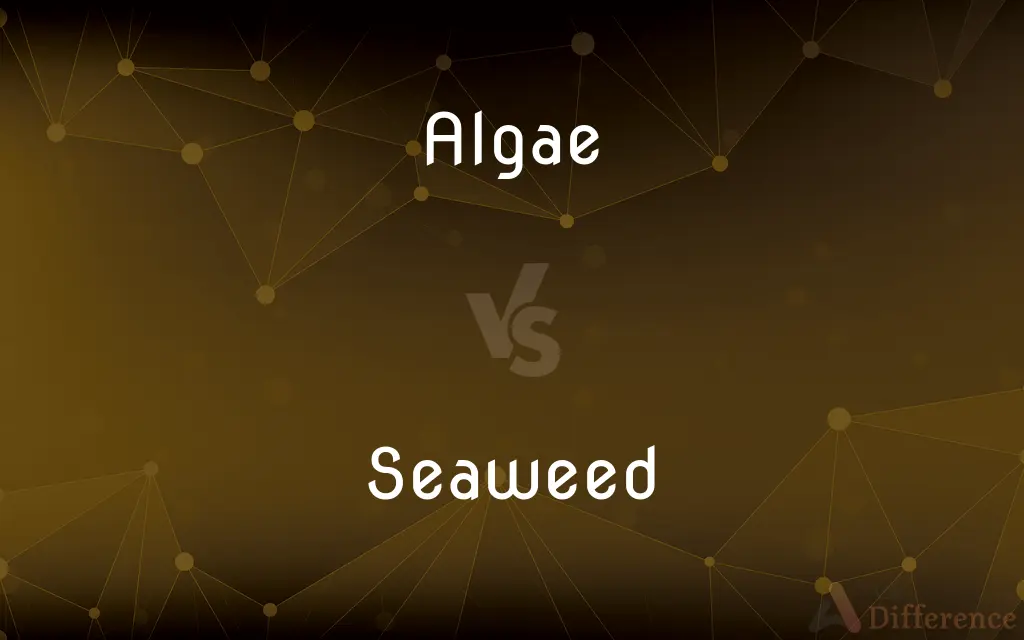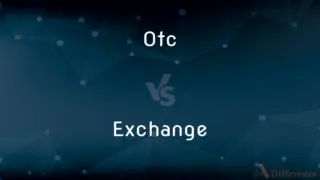Algae vs. Seaweed — What's the Difference?
By Tayyaba Rehman — Updated on October 29, 2023
Algae are simple, photosynthetic organisms, while seaweed is a larger, more complex type of marine algae.

Difference Between Algae and Seaweed
Table of Contents
ADVERTISEMENT
Key Differences
Algae encompass a diverse group of photosynthetic organisms that range from unicellular to multicellular forms, including seaweed. Seaweed, specifically, refers to the larger, more complex multicellular algae that are typically found in marine environments.
Algae are foundational to aquatic food webs, producing oxygen and serving as food for marine life. Seaweed, being a type of algae, shares these ecological roles but is also known for its direct use in human cuisine and industry.
In scientific classification, algae can belong to various groups, including green, red, and brown algae, based on their pigmentation and cellular structure. Seaweed is usually classified within these groups as well, but it denotes the macroscopic, multicellular marine algae within these categories.
Algae are found in a variety of environments, ranging from fresh bodies of water to damp terrestrial locations. Seaweed, on the other hand, is specifically adapted to saltwater environments and is often anchored to rocky substrates.
Algae can reproduce both sexually and asexually, depending on the species and environmental conditions. Seaweed also has complex life cycles that can include both types of reproduction, with some having distinct alternation of generations.
ADVERTISEMENT
Comparison Chart
Complexity
Can be unicellular or multicellular.
Specifically multicellular.
Environment
Found in various environments, including freshwater.
Primarily marine environments.
Size
Range from microscopic to large forms.
Generally large and visible.
Usage
Have broad applications in biofuels, fertilizers, and science.
Used in food, medicine, and cosmetics.
Types
Include many groups like diatoms, green algae, etc.
Types include kelps, nori, etc., within the larger algae categories.
Compare with Definitions
Algae
Aquatic organisms capable of photosynthesis.
Algae produce a significant amount of Earth's oxygen.
Seaweed
Seaweed is often used as an additive in products for its thickening and stabilizing properties.
This ice cream contains seaweed-based thickeners.
Algae
Unicellular or multicellular organisms traditionally classified as plants.
Algae are being researched for their potential as biofuel sources.
Seaweed
Large algae growing in the sea or on rocks below the high-water mark.
Seaweed is often harvested for use in salads and soups.
Algae
Simple nonflowering plants of a large group that includes the seaweeds and many single-celled forms.
Algae thrive in the pond, turning the water a vibrant green.
Seaweed
A term that encompasses numerous species of marine macroalgae.
The coastal cleanup included removing washed-up seaweed from the beach.
Algae
Chlorophyll-containing, usually aquatic organisms.
The aquarium needs cleaning to remove the algae.
Seaweed
Multicellular marine organisms that are often large and colored green, brown, or red.
The rocky shore was covered in a variety of seaweed.
Algae
Diverse group of photosynthetic organisms that are not necessarily closely related.
Algae are studied extensively due to their roles in environmental monitoring.
Seaweed
Marine algae that are edible and rich in vitamins and minerals.
She added seaweed into her diet for its health benefits.
Algae
Algae (; singular alga ) is an informal term for a large and diverse group of photosynthetic eukaryotic organisms. It is a polyphyletic grouping that includes species from multiple distinct clades.
Seaweed
Seaweed, or macroalgae, refers to thousands of species of macroscopic, multicellular, marine algae. The term includes some types of Rhodophyta (red), Phaeophyta (brown) and Chlorophyta (green) macroalgae.
Algae
Any of numerous photosynthetic organisms of aquatic or moist habitats, ranging in size from single-celled diatoms to large seaweeds such as kelp, and characterized by a lack of complex organs and tissues. Once classified within the plant kingdom, the algae are now considered to include several unrelated groups belonging to different kingdoms.
Seaweed
Large algae growing in the sea or on rocks below the high-water mark
Seaweed glistened on the rocks
Seaweeds abound on most shores
Algae
Algal organisms viewed collectively or as a mass; algal growth.
Seaweed
Any of numerous marine algae, such as a kelp, rockweed, or gulfweed.
Algae
(countable) A particular kind of algae.
Seaweed
A mass of such algae.
Algae
Plural of alga.
Seaweed
Any of numerous marine plants and algae, such as a kelp.
Algae
Primitive chlorophyll-containing mainly aquatic eukaryotic organisms lacking true stems and roots and leaves
Seaweed
(by extension) Any of various fresh water plants and algae.
Seaweed
Popularly, any plant or plants growing in the sea.
Seaweed
Any marine plant of the class Algæ, as kelp, dulse, Fucus, Ulva, etc.
Seaweed
Plant growing in the sea, especially marine algae
Common Curiosities
Is seaweed the same as algae?
Seaweed is a type of algae, specifically the larger, multicellular forms found in the ocean.
Do algae only live in salt water?
No, algae can live in saltwater, freshwater, and even damp soil.
Can algae be found on land?
Yes, some types of algae can live in damp terrestrial environments.
Can algae be harmful?
Some algae, like blue-green algae, can produce toxins harmful to humans and animals.
What are algae?
Algae are a diverse group of photosynthetic organisms that can be found in a variety of aquatic environments.
Are all seaweeds edible?
Many seaweeds are edible, but not all; some can be toxic.
How do algae benefit the environment?
Algae produce oxygen and serve as a food source in aquatic ecosystems.
Do seaweeds have roots?
Seaweeds don't have true roots; they have holdfasts that anchor them to surfaces.
Are seaweeds plants?
Seaweeds are algae and not true plants, though they perform photosynthesis.
How do algae reproduce?
Algae can reproduce both sexually and asexually, depending on the species.
Is seaweed used in skincare?
Yes, seaweed is used in skincare for its minerals and antioxidants.
How do you harvest seaweed?
Seaweed is harvested manually or mechanically from the ocean or from seaweed farms.
How do people use algae?
People use algae for nutritional supplements, biofuels, and as fertilizers.
What nutrients are in seaweed?
Seaweed is rich in iodine, vitamins, minerals, and fiber.
Can algae be used as a biofuel?
Yes, some algae can be cultivated to produce biofuels.
Share Your Discovery

Previous Comparison
Devil vs. Imp
Next Comparison
Otc vs. ExchangeAuthor Spotlight
Written by
Tayyaba RehmanTayyaba Rehman is a distinguished writer, currently serving as a primary contributor to askdifference.com. As a researcher in semantics and etymology, Tayyaba's passion for the complexity of languages and their distinctions has found a perfect home on the platform. Tayyaba delves into the intricacies of language, distinguishing between commonly confused words and phrases, thereby providing clarity for readers worldwide.















































